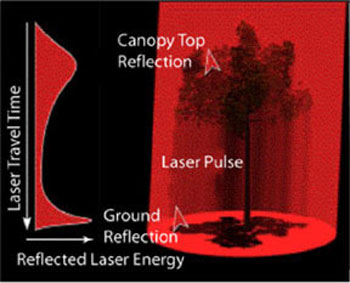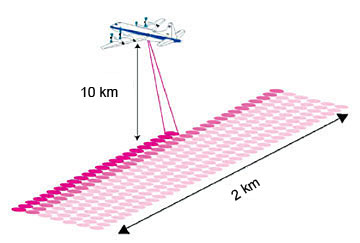A laser altimeter is an instrument that measures range from the instrument
to a target object or surface. The device sends a laser beam towards the target,
and measures the time it takes for the signal to return from striking the surface.
Knowing the precise time the laser pulse was emitted, and the time it took for the
reflection to return yields the range to the target.
There are several common methods for taking this measurement. LVIS employs a signal
digitizer, disciplined with a very precise oscillator, to measure both the transmitted
and reflected laser pulse energies versus time. These digitized and captured photon histories
are known as waveforms. For the outgoing pulse, it represents the profile of the individual
laser shot, and for the return pulse it records the interaction of that transmitted pulse with
the target surface.
Processing of these waveforms yields many products, but the primary is range from the
instrument to the Earth's surface and the distribution of surfaces above the terrain.
Generally these surfaces are trees, branches and other forms of vegetation, buildings and power
lines, and ice crevasses surfaces. LVIS is an
altimeter tailored for collecting large swaths of data from a high altitude aircraft platform.
The laser beam and telescope field of view scan a raster pattern along the surface as the plane
travels over the target area.

Laser Pulse.
The following plot shows a waveform for a laser pulse striking a single tree canopy and
the Earth's surface. Our beam diameter scales with the range to the target (i.e. Gets larger
the farther we are away from the target), and our typical collection size is 5 to 25 meter
spots.
How are 3-D maps made?
To determine the latitude, longitude, and elevation of a given spot on the surface,
it is necessary to know not only the distance to the surface, but the location of the
instrument's platform (i.e., an airplane), as well as the direction the laser altimeter
was looking. GPS, or satellite-based Global Positioning Systems, are used for this purpose.
GPS satellite data is recorded at ground tie locations and on the airborne platform to
precisely reference aircraft. An IMU is attached directly to the instrument, and gives
the pointing information required for coordinate determination.
To create a 3-D map or image of the surface, post flight processing software combines all
the data from the GPS, IMU and LVIS instruments. The resulting 'point cloud' of laser return
data can then be filtered and gridded to generate digital elevation model (DEM) of the
topography or any of the derived data products.
The LVIS transmit beam is scanned perpendicular to direction the aircraft is pointed, as
show in the diagram. The laser scan is adjusted by real time software to remove
platform angle changes as well as forward motion effects. Data on the surface below these
swaths are collected, and a DEM and map can be generated from them. LVIS has a scan angle
of about 12 degrees, and can cover 2 km swaths of surface from an altitude of 10 km.




